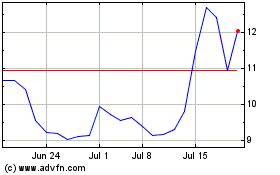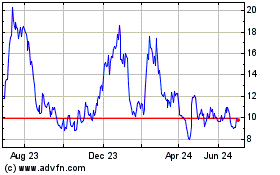Riot Platforms, Inc. (NASDAQ: RIOT) (“Riot” or the
"Company”), an industry leader in Bitcoin (“BTC”) mining
and data center hosting, issues a statement in response to The New
York Times’ (“NYT”) April 9, 2023 article “The Real-World Cost of
the Digital Race for Bitcoin” (the “Article”).
Amid yet another banking crisis, Bitcoin offers consumers and
businesses much-needed optionality for storing value, and the
ability to take custody of their own assets. Bitcoin mining
operations are also providing jobs, tax revenues, and many other
benefits to rural communities, including grid stability and
incentives for alternative energy production.
That is why we were especially disappointed to read a false and
distorted view of our Company and our industry in the Article
published by The NYT. Worse still, The NYT chose to publish the
Article with information its authors knew to be false and
misleading, ignoring the factual information that we provided to
them.
To be clear, our Bitcoin mining operations do not generate any
greenhouse gas emissions, similar to any other data center for
Facebook, Amazon or Google – yet we have been singled out. Our data
center uses electricity from the Texas grid, which is the cleanest
and most renewable energy-sourced grid in the United States.
We also proudly participate in various programs that help to
stabilize the electric grid and actually reduce power prices,
despite what critics incorrectly assume. Unlike other industries,
we can shut down at a moment’s notice, making power available to
other users and critical infrastructure during extreme weather
events, while offsetting losses from curtailing our operations.
We are especially proud to be the largest employer in Milam
County, Texas, and that our dynamic and talented workforce is
spurring economic activity that is strengthening the local
economy.
This reporting appears to be driven by fringe political
interests, but we will not be deterred from our core mission of
helping to build a global, universally accessible network for
Bitcoin and supportive, resilient communities where our operations
are located.
In that spirit, we are compelled to publish here, our full
responses to the NYT questions we received in the weeks prior to
publication. As anyone can see, accurate information was blatantly
ignored because it did not fit the narrative the NYT was trying to
spin.
We wish to highlight below for the public and our shareholders
the truth compared to some of the story’s most glaring
deficiencies, which include at least the following:
1. NYT Distortion: The NYT compares electricity usage of
Bitcoin mining data centers to peoples’ homes. That is an
arbitrary, inflammatory, and political choice. It is very telling
that they compare Bitcoin miners to “another New York City’s worth
of residents.” The NYT appears unaware that this statement admits
condescension towards Americans who choose to inhabit rural areas
in the middle of the country. The obvious implication by the NYT is
that New York City residents should be allowed to consume
electricity; data centers in rural America should not.
Reality: The fact is that nearly any industry that uses
electricity, i.e., manufacturing, other data centers, iron and
steel, chemicals, or even home air conditioners, use orders of
magnitude more electricity, generated by a higher percentage of
fossil fuels, than Bitcoin mining data centers. (See: Cambridge
Bitcoin Electricity Consumption Index (CBECI) (ccaf.io).) The NYT
appears to have singled out this industry because the NYT has tied
itself to political interests opposed to decentralization of
authority. Choosing who can and cannot use energy based on
political considerations is a dangerous path inconsistent with the
values of a free society.
2. NYT Distortion: They state that Bitcoin mining
operations “can create costs” including “higher electricity bills
and enormous carbon pollution.”
Reality: Electricity bills have increased due to a
variety of reasons, including inflationary monetary and fiscal
policy, Russia’s invasion of Ukraine, and restrictive energy
policies by the U.S. federal government. Bitcoin miners do not emit
any pollutants at all. They simply use electricity—just like, say,
electric cars. Bitcoin miners actually decrease electricity bills
by purchasing power at off-peak times and competitively bidding for
demand response programs, which are particularly useful during peak
periods. In making their claims, the NYT relied on a proprietary
hypothetical simulation and failed to open-source the data so that
it can be properly challenged.
3. NYT Distortion: In “Texas … Bitcoin companies are paid
by the grid operator for promising to quickly power down if
necessary to prevent blackouts. In practice, they rarely are asked
to shut down and instead earn additional money while doing exactly
what they would have been doing anyway: seeking Bitcoin.” And they
go on to claim that operators made tens of millions of dollars.
Reality: This is an absurd characterization. How would
Bitcoin miners earn money from a program where they are—according
to the NYT—not participating? Riot is not compensated for
“promises,” we are compensated for providing ERCOT the ability to
directly manage Riot’s energy load. We also invest hundreds of
millions of dollars into developing our business in our Texas
community, for which we are then afforded the right to bid
competitively in demand response programs, in which we are
compensated for selling the curtailment decision to ERCOT. Under
these programs, ERCOT controls Riot’s curtailment in exchange for
competitive, market-based fees.
4. NYT Distortion: “Bitcoin mines bring
significantly fewer jobs, often employing only a few dozen people
once construction is complete, and spur less local economic
development. Their financial benefit flows almost exclusively to
their owners and operators.”
Reality: Notice the selective language here— “often” and
“almost.” The NYT deliberately avoided citing a specific example.
Had they cited Riot, they would have had to admit that Riot
employees hundreds of full-time employees, has used hundreds of
local contractors, and is the largest taxpayer in the county and
school district. They were provided with this information well
before publication and chose to circumvent it rather than
acknowledge it.
5. NYT Distortion: “Many Bitcoin businesses promote their
ability to operate in rural areas where renewable energy is
abundant. But those claims have hit a hard reality: A vast majority
of that renewable energy would be used even in the absence of the
mines, so fossil fuel plants almost always need to produce
additional electricity as a result of their operations.” They go on
to state that Riot operates on 96% fossil fuel, using a “marginal
emissions” calculation.
Reality: This is utterly baseless and nonsensical. Riot
purchases electricity from the Texas energy grid, which uses
approximately 24% wind, 10% nuclear, and 4% solar. (See: Texas’
Energy Profile.) However, Riot operates exclusively in rural areas
where wind and solar are abundant and otherwise wasted during
off-peak times, thereby further diversifying the grid’s energy mix
and leaning much more heavily on renewable sources. The NYT even
admits that “renewable generation takes years to build and usually
requires commitments from customers who can guarantee that they
will buy power for a decade or more.” Bitcoin miners make such
commitments and are ideally positioned to do so.
6. NYT Distortion: “If Riot had been fully operating [on
June 23, 2022], it would have incurred an estimated $5.5 million in
fees — costs that are largely made up by other Texans. Over the
course of the year, this saved Riot more than $27 million in
potential fees.”
Reality: We believe this is false and demonstrates a
total lack of understanding of power markets. Riot provided the NYT
with a rational and factual explanation to clarify this erroneous
statement, which can be found in the link provided above. We even
noted that that it was “unclear” regarding what data they could
possibly be referring to.
By implication, the NYT’s preference appears to be that Riot
should refuse to curtail so that it pays higher fees; yet the
implication of the entire article is that Bitcoin miners should not
be allowed to operate at all. Both of these alternate realities are
incongruous and insidious.
The fact of the matter is that Riot participates in many of
ERCOT’s ancillary services programs, which add to grid reliability
and ultimately reduce power prices, benefiting all of the tens of
millions of ERCOT customers. Riot is proud to do so.
About Riot Platforms, Inc.
Riot’s (NASDAQ: RIOT) vision is to be the world’s leading
Bitcoin-driven infrastructure platform.
Our mission is to positively impact the sectors, networks and
communities that we touch. We believe that the combination of
an innovative spirit and strong community partnership allows the
Company to achieve best-in-class execution and create successful
outcomes.
Riot is a Bitcoin mining and digital infrastructure company
focused on a vertically integrated strategy. The Company has
Bitcoin mining data center operations in central Texas, Bitcoin
mining operations in central Texas, and electrical switchgear
engineering and fabrication operations in Denver, Colorado.
For more information, visit www.riotplatforms.com.
Safe Harbor
Statements in this press release that are not historical facts
are forward-looking statements that reflect management’s current
expectations, assumptions, and estimates of future performance and
economic conditions. Such statements rely on the safe harbor
provisions of Section 27A of the Securities Act of 1933 and Section
21E of the Securities Exchange Act of 1934. Because such statements
are subject to risks and uncertainties, actual results may differ
materially from those expressed or implied by such forward-looking
statements. Words such as “anticipates,” “believes,” “plans,”
“expects,” “intends,” “will,” “potential,” “hope,” and similar
expressions are intended to identify forward-looking statements.
These forward-looking statements may include, but are not limited
to, statements about the benefits of acquisitions, including
financial and operating results, and the Company’s plans,
objectives, expectations, and intentions. Among the risks and
uncertainties that could cause actual results to differ from those
expressed in forward-looking statements include, but are not
limited to: unaudited estimates of Bitcoin production; our future
hash rate growth (EH/s); the anticipated benefits, construction
schedule, and costs associated with the Navarro site expansion; our
expected schedule of new miner deliveries; our ability to
successfully deploy new miners; M.W. capacity under development; we
may not be able to realize the anticipated benefits from
immersion-cooling; the integration of acquired businesses may not
be successful, or such integration may take longer or be more
difficult, time-consuming or costly to accomplish than anticipated;
failure to otherwise realize anticipated efficiencies and strategic
and financial benefits from our acquisitions; and the impact of
COVID-19 on us, our customers, or on our suppliers in connection
with our estimated timelines. Detailed information regarding the
factors identified by the Company’s management which they believe
may cause actual results to differ materially from those expressed
or implied by such forward-looking statements in this press release
may be found in the Company’s filings with the U.S. Securities and
Exchange Commission (the “SEC”), including the risks, uncertainties
and other factors discussed under the sections entitled “Risk
Factors” and “Cautionary Note Regarding Forward-Looking Statements”
of the Company’s Annual Report on Form 10-K for the fiscal year
ended December 31, 2021, as amended, and the other filings the
Company makes with the SEC, copies of which may be obtained from
the SEC’s website, www.sec.gov. All forward-looking statements
included in this press release are made only as of the date of this
press release, and the Company disclaims any intention or
obligation to update or revise any such forward-looking statements
to reflect events or circumstances that subsequently occur, or of
which the Company hereafter becomes aware, except as required by
law. Persons reading this press release are cautioned not to place
undue reliance on such forward-looking statements.
Alexis Brock
Riot Platforms, Inc
5129406014
PR@riot.inc
Phil McPherson
Riot Platforms, Inc.
303-794-2000 ext. 110
IR@riot.inc
Riot Platforms (NASDAQ:RIOT)
Historical Stock Chart
From Jun 2024 to Jul 2024

Riot Platforms (NASDAQ:RIOT)
Historical Stock Chart
From Jul 2023 to Jul 2024
